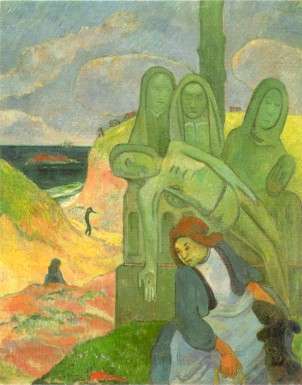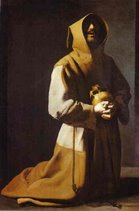 I first learned of the Annunciation from “My Catholic Devotions,” a book that had pastel-colored pictures depicting the mysteries of the rosary. My mother let us look at the pictures while reciting our Hail Mary’s, so we memorized words and images.
I first learned of the Annunciation from “My Catholic Devotions,” a book that had pastel-colored pictures depicting the mysteries of the rosary. My mother let us look at the pictures while reciting our Hail Mary’s, so we memorized words and images.

I was compiling quotes from George Balanchine on religion and I realized how right he was about one thing: children have to learn faith when they’re young, or they will never have it.
Adult converts can have
something – a turning over of mind and heart to the Lord, but the natural belief in the supernatural, the nearness of transcendence, the
ritual will always be somewhat off.
Can adult converts really have the suspicions that children can: that dragonfly wings sound like what one’s guardian angel’s wings sound like, or that the movement of the wind was the Mother of the Lord sighing just for you to hear it, or that the sun beaming through the window was Christ Himself wishing you a personal Good Morning?
Perhaps, but adults have to struggle against skepticism to believe in it; it all comes so naturally to children.
This is where the importance of the example of
St. Anne and St. Joachim comes in – could Mary have believed Gabriel without those saints as parents?
As a child, I believed that if I were silent enough, I could hear my guardian angel hovering around me.
She had wings and was a bit naughty – if I sat in complete silence, the sound of the air conditioner coming on at the exact same moment as I appealed to her was her form of communication.
Was I a crazy child who didn’t understand probability and coincidence?
Religion is first learned in the home. It matters not that you take your children to Mass every Sunday if you don’t pray with them two or three times a day, and if they don’t see YOU praying several times a day. But it’s not just the indoctrination they need; it is also the feel of the rhythm of prayer in their lives. These have to be absorbed when we are sponges, before the second-guessing. It’s striking to me that when I pray, there are prayers I can only say aloud, or at least only when moving my lips. These are the prayers that I learned not from the printed page, but from my mother’s lips, the ones I gradually learned to recite with her. There are certain prayers my mother says back-to-back, like the Hail Holy Queen and the Memorare, that now strike me as overdoing it, if saying prayers to Mary can be overdone. (Why not at least insert the Prayer to St. Michael between them for a little diversion, Mom?) And yet this is what I do every time too. I also find it impossible to say certain prayers while reading them – I get lost in the text itself and the meaning - the visceral and spiritual sensation - disappears.

There are phrases that I’ve always thought of as tongue twisters: “that we may be made worthy of the Promises of Christ,” yet I can’t imagine changing it to something simpler (“It’s easier in Latin!” a certain person is no doubt thinking right now.) In CCD class in junior high school, besides doing poor remedial Catholic catechesis, our ‘teachers’ (I use the term loosely) would give us tests: recite the Our Father, Hail Mary, and Glory Be. Most of my fellow CCD attendants didn’t know these prayers and neither did their parents, suggesting that the wheels were off in Protestant America before Vatican II, except in those places where Catholicism had firmly taken root. Our CCD teachers would also teach us an “easy” version of the Act of Contrition that went something like this: “God, I am sorry for my sins. Please forgive me, and help me to avoid sinning again.” That’s no way to instill Catholic guilt! Even worse, it misses the meditation on one’s sins that the older version features: “…but most of all because it offends You, My God, Who are all good and deserving of all my love.” I think it got dumbed down out of fear people didn’t understand the words they were saying, and could be more reflective if the text were easier. Who cares? Formal prayer isn’t about getting all the words right, or about understanding everything you are saying (if that were true, most of my formal prayers from the time I could speak to the age of seven were for naught). It’s about creating an atmosphere like an enclosed aquarium, separate from the real world, that you can fly or swim around in for several minutes, a place where the mundane and pedestrian do not have entrance. It’s not about getting the words right, it’s about getting the spirit.

A.V. has a problem with Low (Laudes) Sunday becoming Divine Mercy Sunday by decree of John Paul II. I’m not about to get into a liturgical argument with A.V. - I don’t pick fights I can’t win – but I have always liked the Divine Mercy Chaplet. My mom is a Third Order Carmelite, and so she’d bring all manner of prayer cards and third class relics home with her from meetings. I remember learning the Divine Mercy prayers fairly early on and I think we Catholics know a good prayer when we hear it. My mom would also sometimes have to glue and sew Brown Scapulars, and every now and then I would help her do so. It was fun to ‘have the inside track’ on those religious items that people, believing in the promises of Our Lady to St. Simon Stock, devoutly wear. But it was also wonderful to know that these religious items were touched again and again by human hands, touched with love and fingers pressed on the image on the front. I would ask my mom if the promises applied to even those who didn't believe, and she'd respond, "Only God knows...why do you ask so many questions?"
The favorite prayer of both my mother and grandmother is the Prayer of St. Francis of Assisi: “Lord, make me an instrument of your peace...” I was too much of a warmonger, too much in the “life is injustice, and that’s wrong” vein to say this devoutly; I needed prayers that would inspire me to win or that guarantee some form of win. But I was at least not so stupid to have not loved these lines:
O Divine Master, grant that I may not so much seek to be consoled as to console;
to be understood as to understand;
to be loved as to love.
For it is in giving that we receive;
it is in pardoning that we are pardoned;
and it is in dying that we are born to eternal life.

Paintings are works of Francisco de Zubarán (1598-1662), The Annunciation (1638-9), The Archangel Gabriel (1631-2), The Holy House at Nazareth (1630), Agnus Dei (1635) and St. Francis Kneeling (1635-9).






 Titian, c 1554
Titian, c 1554
















